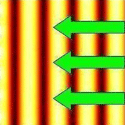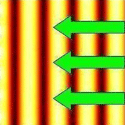One-way sound
In an electronic circuit, diodes conduct current in only one direction. An analogous device, called an acoustic diode, exists for sound waves. Since these diodes are typically made from sonic crystals—artificial materials that only block sound waves that lie in a particular frequency range—they are often of limited practical use.
Writing in Physical Review Letters, Xue-Feng Li and colleagues at Nanjing University, China, and the California Institute of Technology report on a new acoustic diode design that manipulates the sonic crystal itself to achieve nonreciprocal propagation of sound. The device consists of a two-dimensional sonic crystal arranged in a mesh of square steel rods. By rotating the steel rods, Li et al. are able to manipulate the unit cell of the sonic crystal element to turn the diode on (sound waves only propagate one way) and off (sound waves can move back and forth). Furthermore, Li et al. make their device entirely from linear acoustic materials, which allows them to control sound propagation with a simpler and more efficient process, over a broader bandwidth, and with lower power consumption, compared to existing nonlinear sonic-crystal-based devices. – Daniel Ucko





